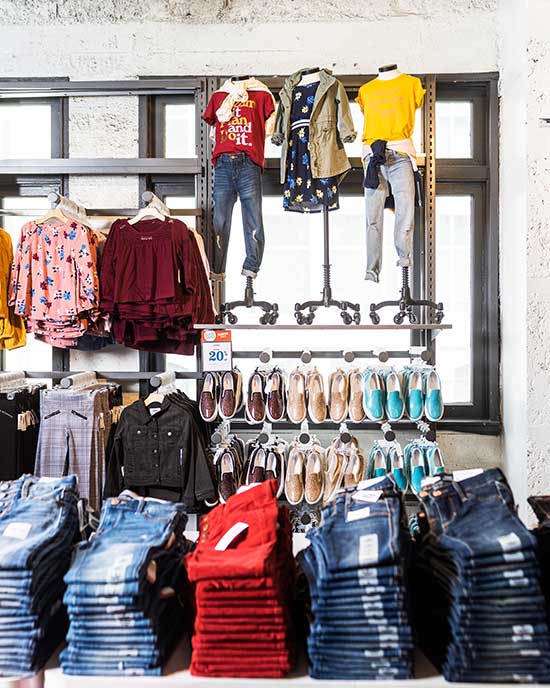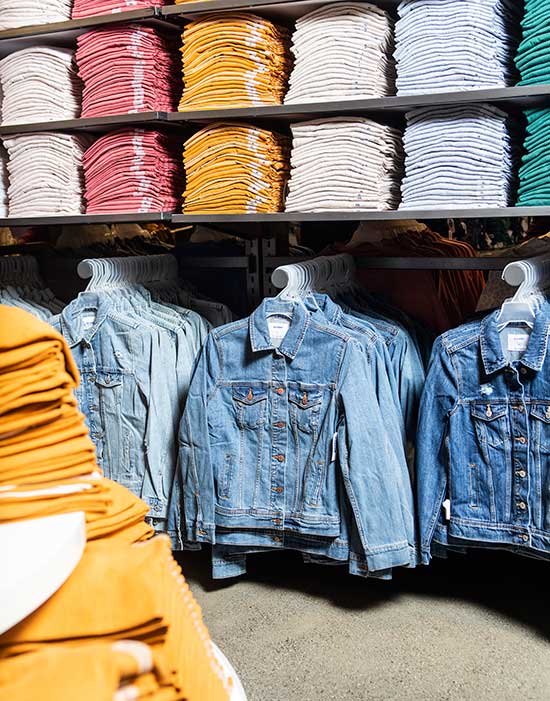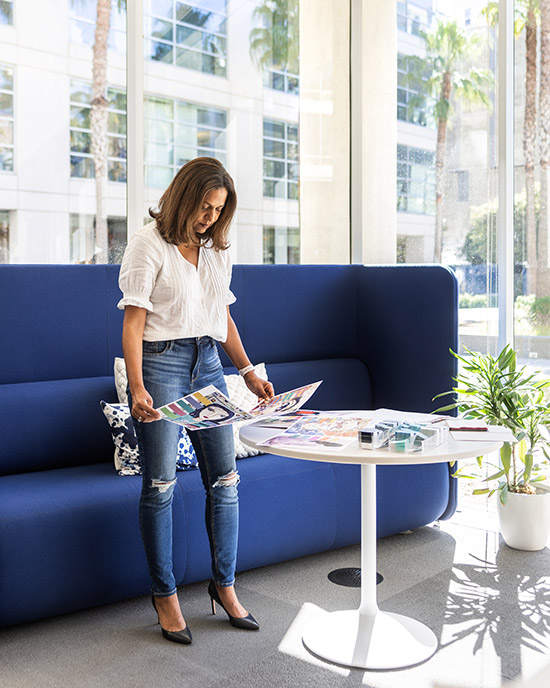离开老东家,老海军即将驶入风浪区

|
不久前的一个周一,当Old Navy的员工走进旧金山总部时,几乎是在进门的那一刻就迎来了顾客直截了当的反馈。一位购物者提醒说:“队伍排得太长了,而且你们的客服代表一点儿也帮不上忙……”另一位顾客则失望地表示:“要是我在YouTube上再看到Old Navy的广告……” 这些抱怨来自于Old Navy的社交平台。在大前台后方的液晶屏幕上,这些醒目的红色滚动字幕在员工的头顶上嗖嗖地闪过。在Old Navy的首席执行官索尼娅·辛格尔的要求下,去年这家平价时尚连锁公司设在Mission Bay区的大型总部安装了这块液晶屏。屏幕上的评论往往是称赞多于批评,诸如:“我买过的最好的牛仔服”和“我一直讨厌牛仔裤,直到发现了rockstar”(称赞的评论会以蓝色显示)。不过,在液晶屏上滚动播出批评和赞许的目的是让这个品牌持续掌握购物者的情况。在未来的一年中,对辛格尔和她的团队来说持续了解实际情况可能会尤为重要。 在2020年的某个时刻,最有可能是上半年,Old Navy将从母公司Gap Inc.中剥离出去。届时,这个年销售额接近80亿美元的品牌将作为独立上市公司开启自己的新历程(投资者持有的Gap股份将转换成同等数量的Old Navy股份)。有25年历史的Old Navy将首次完全凭借自身实力来实现腾飞或是沉沦,而与Gap和Banana Republic等其他母公司顶尖品牌再无瓜葛。同时,后者的滑坡表明在竞争残酷的服装行业成功是多么的脆弱。辛格尔对《财富》杂志表示:“我们公司的所有成员现在都将执着于服务Old Navy及其客户。”如果其关注点出现偏差,他们只需要抬头看看横亘在大门口的那块液晶屏就行了。 多年来,Old Navy一直是支撑Gap的发动机,这得益于它的经营模式,即销售流行而且价格不高的基本款服饰,如短裤和抓绒运动服,并将这些服装以略显随意的方式摆在生气勃勃的店铺中。Old Navy为Gap贡献了近一半收入和很大一部分利润。欧睿国际的数据显示,Old Navy是美国第二大服装品牌,仅略逊于耐克。2011年以来,Old Navy的全球销售额增长了20亿美元,增幅为35%,这几乎是Gap在这段时间里的全部新增收入。如此成功的表现在很大程度上要归功于辛格尔,这位资深硅谷人士的物流特长让Old Navy能够异常熟练地推出让人称心如意的新产品,速度很快而且价格亲民。 不过,即将作为独立CEO开启新旅程的辛格尔面对的是“风浪区”。用华尔街的行话来说,剥离Old Navy是“释放其价值”的途径,不会被陷入困境的兄弟品牌所拖累。但Old Navy自己最近却出现了大滑坡。它的可比销售额(不包括新门店和最近关闭门店的销售数据)已经连续两个季度下挫,该公司称原因是顾客过于关注Old Navy的老产品。 其他威胁也在逼近。塔吉特(去年在美国实现自有品牌服装销售额52亿美元,排名行业第三)、沃尔玛、T.J. Maxx以及欧洲的Primark等低价竞争对手都紧追Old Navy不放。加之经济有可能衰退,投资者对本次剥离不是那么兴高采烈就没有什么可奇怪的了。目前Gap的股价约为19.5美元,而在今年2月刚刚宣布上述剥离计划时,其股价为29.51美元。 不过,如果辛格尔和她的上司,也就是即将成为竞争对手的Gap首席执行官阿特·派克是对的,实际情况就会表明Old Navy的滑坡只是短暂的周期性现象。成为一家独立企业将有助于摆脱这些负面因素,辛格尔这次赌了一把;实际上,她已经表示要将年销售额再提升25%,达到100亿美元,并将店铺数量增加近一倍,只是未说明实现这些目标的具体时间。她把Old Navy比作已经为离家做好准备的少年。她说:“我们可以走的更快。” |
Old Navy employees heading into their San Francisco headquarters on a recent Monday were greeted almost the second they walked in with some bluntly candid customer feedback. “The lines are way too long & your customer service reps are not helpful at all,” griped one shopper. “If I get served one more Old Navy ad on YouTube …” lamented another. The complaints, taken from Old Navy’s social media feeds, whizzed high above staffers’ heads in vivid red type as a chyron streaming across an LED screen behind the main reception desk. The chyron was installed last year at the low-cost fashion chain’s sprawling home office in the Mission Bay district, under orders from Sonia Syngal, Old Navy’s CEO. The electronic comments often include more bouquets than brickbats. “Best jeans I have ever owned” and “I hated jeans until I discovered the #rockstar” read other messages (displayed in blue type because they were laudatory). But the whole light show of recrimination and adulation is designed to keep the brand attuned to its shoppers. And that perpetual reality check could feel especially urgent for Syngal and her team over the coming year. Sometime in 2020, most likely in the first half, Old Navy, a brand with nearly $8 billion a year in sales, will begin life as a stand-alone, publicly traded company, after its parent, Gap Inc., spins it off. (Gap investors will get one Old Navy share for each share they own in the parent company.) For the first time in its 25-year history, Old Navy will soar or sink on its own merits, free of a parent whose other top brands—Gap and Banana Republic—have endured declines that show how tenuous success can be in the pitilessly competitive apparel industry. “Everyone in the company will now be obsessed with serving Old Navy and the Old Navy customer,” Syngal tells Fortune. And if their focus wavers, they can just look up at the screen as they swipe their building pass. For years, Old Navy has been the motor sustaining Gap Inc., thanks to its formula of selling trendy but inexpensive versions of basics like shorts and performance fleece, presented with a touch of whimsy in lively stores. Old Navy generates nearly half of Gap’s revenues and the bulk of its profit. According to Euromonitor International, it is the second-largest clothing brand in the U.S., a hair behind Nike. The brand’s global sales have risen $2 billion, or 35%, since 2011, accounting for essentially all of Gap Inc.’s revenue growth during that span. And much of that success has been owing to Syngal, a Silicon Valley veteran whose knack for logistics has helped make Old Navy unusually deft at rolling out desirable new merchandise, quickly and inexpensively. But Syngal’s inaugural voyage as an independent CEO faces choppy waters. In Wall Street parlance, hiving off Old Navy is a way to “unlock its value,” unhindered by its struggling siblings. But Old Navy has recently hit a slump of its own. The brand’s comparable sales (which exclude figures from new or recently closed stores) have fallen two quarters in a row, following a lackluster holiday season—a stumble that analysts and the company attribute to customers seeing too much of the same-old, same-old in Old Navy’s offerings. Other threats loom as well. Low-priced competitors, including Target (which rang up $5.2 billion in U.S. private-label apparel sales last year to rank No. 3 in that category), Walmart, T.J. Maxx, and European discounter Primark, are nipping at Old Navy’s heels. Stir in the possibility of a recession, and it’s little wonder why investors are less than euphoric about the spinoff: Gap Inc. shares are trading at around $19.50, down from $29.51 right after the move was announced in February. Still, if Syngal and her boss—and soon-to-be competitor—Gap Inc. CEO Art Peck are right, Old Navy’s slump will prove to be a short, cyclical blip. Being a stand-alone will help shake the funk, Syngal is betting; indeed, she has vowed to lift annual sales an additional 25%, to $10 billion, and to nearly double its store fleet, though she hasn’t set a firm timetable for those goals. She compares Old Navy to the proverbial teen who is ready to leave home. “We’ll be able to move faster,” she says. |
****
|
Old Navy的起源可以追溯到1993年,时任Gap CEO 的米基·德雷克斯勒凭直觉感到人们开始认为购买低价服装并不丢人。他把48家表现低迷的Gap店铺改造成了“仓库”,尝试销售价格低于Gap及其竞争对手但质量高于折扣连锁服装店的服装,而且购物环境相对于这些连锁店也更好。Gap内部的说法是,德雷克斯勒在去巴黎的路上看到一家酒吧屋顶上写着“Old Navy”,就把这个名字用在了自己的新概念上。1994年,第一家Old Navy店铺开门营业。 实际情况表明,服装质量接近“百货商场店铺”而价格较低是一个致胜组合。当时,一件Old Navy运动衫可能含棉50%,没有含棉85%的Gap运动衫那么“天然”,但比沃尔玛等零售商的同类商品含棉量高。令人难忘的古怪广告成了Old Navy的助推器,时尚编辑卡丽·多诺万和她的超大号眼镜、女演员摩根·费尔切尔德和Magic the Dog都曾经出现在这些广告中。 节俭的妈妈和预算有限的时装设计师们发现,价格不高再也不一定意味着乏味和死板。咨询公司SW Retail Advisors的总裁斯泰西·韦德里茨说:“对那些消费者而言,Old Navy的性价比一直是市场上最高的。”它马上开始夺走J.C. Penney、塔吉特和西尔斯等零售商的市场份额。投入运营四年后,Old Navy的价值已经达到10亿美元,成为第一家如此迅速地达到这一里程碑的服装连锁店。 |
Old Navy’s origins date to 1993, when Gap Inc.’s then-CEO, Mickey Drexler, intuited that the stigma around bargain-priced clothes was dissipating. Drexler converted 48 weak Gap stores into “warehouses” to experiment with selling clothes that were cheaper than those at Gap and its rivals but of higher quality than discount chains offered and in a nicer environment. Company lore has it that on a trip to Paris, Drexler saw the words “Old Navy” above a bar and settled on that name for the new concept. In 1994, the first Old Navy stores opened. Offering clothing of nearly “mall store” quality at low prices proved to be a winning formula. An Old Navy sweatshirt of that era might have been 50% cotton and thus less “natural” than the 85% cotton top you’d find at Gap but more so than an equivalent item at, say, Walmart. Memorably quirky ad campaigns featuring fashion editor Carrie Donovan and her oversize glasses, actress Morgan Fairchild, and Magic the Dog propelled the brand. Thrifty moms and fashionistas on a budget took notice: Inexpensive didn’t have to mean boring and square anymore. “They’ve been the best value in the market for that consumer,” Stacey Widlitz, president of SW Retail Advisors, says of Old Navy. The chain immediately started to take market share from the likes of J.C. Penney, Target, and Sears. By its fourth birthday, Old Navy was a $1 billion brand, the first clothing chain ever to reach that milestone so quickly. |

|
如今,Old Navy的审美已经在平价时尚领域处于主导地位。穿一件9美元的T恤衫,再加上设计师签名挎包,这在别人眼中就会成为时尚达人,而不是菜鸟。每年7月第四周的Old Navy 1美元人字拖甩卖和5美元美国国旗T恤衫促销已经深深融入了这种文化之中。在它的唯一海外市场加拿大,由于加拿大总理贾斯汀·特鲁多穿着Old Navy粉色亚麻衬衫参加了2016年的多伦多LGBT骄傲游行,随之掀起了一阵热潮。研究公司Prosper Insights & Analytics的数据显示,Old Navy顾客的平均年龄为39岁,其家庭年收入为75000美元,没有塔吉特和Gap的消费者那么富裕,但更重要的是,他们较为年轻。 多样性是让这些消费者变成回头客的秘诀。虽然Old Navy是购买基本款服装的必去之处,但它最主要的资产之一就是能够迅速推出令人惊讶的新款商品,从而让购物者获得“寻宝”心态,这在低利润率服装领域十分关键。举例来说,在上一个假期购物旺季,Old Navy售出了1000万双带有雪人或企鹅等季节性萌物图案的保暖短袜,从而避免了表现平庸的季度业绩。纽约时装技术学院的助理教授雪莉·科恩说:“如果他们不断推出新产品,担心自己失之交臂的消费者就会一直蜂拥而来。” 保持这样的客流需要卓越的运营,而索尼娅·辛格尔就是这样成了CEO。 |
Today, the Old Navy aesthetic is just as dominant in middlebrow fashion: Wearing a $9 T-shirt with a designer bag is seen as savvy, not gauche. The brand’s annual $1 flip-flop sale and the $5 American flag tee it sells around the Fourth of July are ingrained in the culture. Old Navy created a buzz in Canada, its only major international market, when Prime Minister Justin Trudeau wore one of its pink linen shirts to Toronto’s 2016 LGBT pride parade. According to Prosper Insights & Analytics, the average Old Navy shopper is 39 and comes from a household with income of $75,000. That makes those shoppers slightly less affluent that those at Target and Gap—but more important, they’re younger. Variety is the secret sauce that keeps those customers coming back. While Old Navy is a go-to store for basics, one of its biggest assets is its ability to speedily roll out surprising new items, creating the “treasure hunt” mentality that’s crucial in the low-margin apparel world. Last holiday season, for example, during an otherwise underwhelming quarter, Old Navy sold 10 million pairs of cozy socks depicting cute seasonal beings like snowmen or ¬penguins. “If they keep bringing in new product, their customer, for fear of missing out, will keep popping in,” says Fashion Institute of Technology assistant professor Shelley Kohan. Keeping that stream flowing requires operational excellence—and that’s how Sonia Syngal came to be CEO. |
****
|
现年49岁的辛格尔从青春期开始就一直喜爱技术和时尚。她在加拿大长大,青少年时期是个瘦高个,当时她发现许多服装品牌跟她都没有交流,或者穿着不合适。辛格尔回忆说:“我找到衣服穿很不容易。”所以她自行设计并制作了很多衣服,甚至还给朋友和家人做。虽然只有十几岁,但在蒙特利尔的流行时尚文化启发下,她已经建立了自己的公司Style Montreal。 辛格尔尤其喜欢生产和经销服装涉及的物流过程,这把她带进了科学和工程领域。她上了凯特林大学,这座设在密歇根州弗林特市的大学和通用汽车有很深的渊源,并以STEM(科学、技术、工程和数学)为教育重点。辛格尔达到了福特金牛座轿车工厂的工作和学习要求。21岁的她成了该厂罕见的女性员工,这让厂里50多岁的男性雇员感到吃惊,辛格尔回忆说,这是一段艰难但关键的早期职业学习经历,她是通过和男工友开玩笑来适应环境的。辛格尔在斯坦福大学获得了制造系统专业硕士学位,也是在那里遇到了自己的丈夫。随后,辛格尔在太阳微系统公司的制造团队中工作了几乎10年时间。 然而,零售行业仍在召唤她。辛格尔说:“这始于我对时尚的热爱以及服装是穿着艺术的纯粹理念。”同时,建立和运营供应链满足了她左半脑的需求。辛格尔还说,和科技领域相比,零售行业的环境对女性更友好,女性董事和高管所占比重更大,而这并不让人感到受伤。同工同酬对零售业女性来说也更为普遍。实际上,Gap就有同工同酬的规定,而且这一传统可以一直追溯到1969年,也就是多丽丝和唐纳德·费舍夫妇分别出资2.1万美元建立这家公司的时候。辛格尔在Gap得到了第一份(作为成年人的)零售业工作——2004年她出任该公司资源策略副总裁。 |
Syngal, now 49, has been passionate about both technology and fashion since her adolescence. As a lanky teen growing up in Canada, she found that many clothing brands didn’t speak to her or fit her well. “I was not easy to dress,” Syngal recalls. So she designed and made much of her own clothing and eventually did the same for friends and family. While still a teenager, she started her own small company, Style Montreal, inspired by that city’s trendy fashion culture. But Syngal particularly liked the logistics involved in making and distributing clothes, which led her toward science and engineering. She went to Kettering University, a college long associated with General Motors in Flint, Mich., that focused on STEM education. She met the work/study requirements by working the floor at Ford’s Taurus sedan factory. Being the rare woman on the floor, and a 20-year-old one at that, and supervising men in their fifties was a tough but crucial early career learning experience, Syngal recalls; she navigated the environment in part by cracking jokes with the boys. Syngal later got a master’s in manufacturing systems at Stanford—where she met her husband—and then worked at Sun Microsystems on its manufacturing team for almost a decade. But retail still called to her. “It starts with my love of fashion and the pure notion that clothing is wearable art,” Syngal says. The idea of building and operating supply chains, meanwhile, satisfies her left-brain needs. It doesn’t hurt, she adds, that retail is a more woman-friendly environment than tech, with a bigger proportion of women sitting on boards and in the C-suite. Equal pay for women is also more common in retail. In fact, it’s the rule at Gap Inc., a tradition with roots dating back to its founding in 1969, when spouses Doris and Donald Fisher each put in $21,000 to launch the company. It was there that Syngal took her first (adult) job in retail, as a vice president of sourcing strategy, in 2004. |

|
辛格尔在Gap的升迁与行业思路的转变同时出现。许多年来,各个服装品牌一直在所谓的商业王子和公主中间寻找CEO,这些人能够通过直觉发现购物者会买哪些商品。但Gap的CEO派克认为,经营能力是最重要的,特别是在业务量很大的连锁企业。派克指出,Old Navy的80亿美元收入来自于“每笔9.20美元的买卖”,这是指它的平均商品价格。大家可以想一想,Old Navy每年要出售7亿件服装,同时要推出4000种新产品或变体产品,这种情况下物流就不仅仅是纸上谈兵,它堪称这家公司的生命线。Gap的非执行董事长、该公司的创始人之子罗伯特·费舍说:“你得灵活对待消费者数据,并且同样灵活地对待电子商务规划以及店铺中商品的销售。” 大衰退前和衰退期间,Old Navy都在努力对付H&M、Zara等低价流行品牌带来的激烈竞争,这些品牌专门寻找新的时尚并迅速向市场推出产品来满足相应需求。与此同时,2006-2008年Old Navy的销售额下降了10亿美元以上。几年后,时任该品牌CEO的斯特凡·拉尔森决定终止他给Old Navy定下的“以磅卖衣”的方法,并把更流行的产品更快地放在店里。这就意味着通过重组来建立更迅速的供应链,而这正是辛格尔的强项。此前经营Old Navy国际业务的辛格尔于2013年成为Gap的供应链和产品运营总负责人。在物流领域的成功则为她接替拉尔森的职位铺平了道路——2016年拉尔森离开Old Navy,接掌拉尔夫·劳伦。 虽然所有Gap品牌都使用同样的物流业务,但速度更快的时尚运营对Old Navy的影响更大,这个品牌的文化也更具试验性和趣味。在辛格尔治下,Old Navy率先采用的一项最佳措施就是先购买大量布料,然后再决定用来做什么,这样能够更好地利用意外出现的流行趋势。Gap和Banana Republic随后也采用了这样的做法。Old Navy还建立了16亿美元的庞大在线业务,其动力则来自于辛格尔时代的另一项创新,那就是让线上订单实现店内取货的快递服务,被称为“闪电时尚”。 分析对服装生产商的战略决策变得越来越重要,这让辛格尔的技术背景变得更有价值。但这并不是说这些年来Old Navy没有失误过——想到几年前推出的金光闪闪的浴袍,辛格尔就会觉得尴尬。但她从不为这样的事情道歉,比如,Old Navy通过分析押注复兴的男式工装短裤(这让许多美国女性感到不满)。辛格尔则打趣说:“可怜的男士们,他们连手包都没有。”不过,这种多兜短裤现在已经不那么宽松了。此外,辛格尔的数据告诉她男性想要这种短裤。她非常成功地拓展了Old Navy的大尺码服装。现在,女式连衫裤开始流行起来,Old Navy也开始在这方面着手。辛格尔说:“两年后美国人会穿什么呢?我们的工作就是弄清楚这一点。” |
Her ascent at Gap has coincided with a shift in thinking in the industry. Clothing brands for many years had sought their CEOs among so-called merchant princes and princesses, people with a knack for intuiting which merchandise shoppers would buy. But today, says Gap CEO Peck, operations expertise is paramount, particularly at a high-volume chain. Old Navy gets to $8 billion in revenue “$9.20 at a time,” Peck notes, referring to its average revenue per item. When you consider that Old Navy sells 700 million clothing items a year, and introduces 4,000 new products or product variations every year, logistics aren’t just a nerdy consideration: They are the corporate lifeblood. “You’ve got to be equally agile with consumer data as you are with how to plan e-commerce, and as how you merchandise the store,” says Gap’s nonexecutive chairman Robert Fisher, a son of the founders. Before and during the Great Recession, Old Navy struggled with intense competition from cheap but trendy brands like H&M and Zara, which specialized in spotting new vogues and rushing products to market to satisfy them. Old Navy’s sales, meanwhile, declined more than $1 billion between 2006 and 2008. A few years later, Stefan Larsson, then the brand’s CEO, decided to end what he’d called Old Navy’s “clothes by the pound” approach and get more on-trend products into its stores faster. That meant building a quicker, rejiggered supply chain—and that, in turn, played to Syngal’s strengths. After a stint running Old Navy’s international business, she became head of supply-chain and product operations for all of Gap Inc. in 2013. And her successes in logistics paved the way for her to succeed Larsson as CEO in 2016, after he left to take the helm at Ralph Lauren. While all the Gap brands have shared supply-chain expertise, faster-fashion practices have had a bigger impact at Old Navy, where the culture is more experimental and playful. One best practice pioneered at Old Navy under Syngal, which Gap and Banana Republic have since adopted, involves buying huge amounts of fabric ahead of time and only later deciding what to make with it, the better to jump on an unexpected trend. Old Navy has also built a massive $1.6 billion online business, with a boost from another Syngal-era innovation: a “Fashion in a Flash” express line for in-store retrieval of online orders. Syngal’s tech background is becoming even more valuable given the growing role of analytics in guiding apparel makers’ strategic choices. That’s not to say Old Navy hasn’t had misfires over the years: Syngal cringes at the memory of the gold lamé bathing suits the chain tried to sell a few years ago. But she makes no apologies, for example, about Old Navy’s analytics-driven bet on men’s cargo shorts, a garment enjoying a renaissance (to the chagrin of many American women). “Poor guys, they don’t get to carry a purse,” Syngal quips. Still, the multipocketed shorts tend to be less baggy now. Besides, Syngal’s data tells her that men want them. Syngal has expanded the brand’s plus-size selection with great success. Now, jumpsuits for women are trending, and Old Navy is on it. “What will Americans be wearing in two years?” Syngal asks. “That’s our job to figure out.” |
****
|
多年来,Old Navy在这方面的决策一直好于兄弟品牌,这也有助于延缓后者的崩溃。Gap品牌曾经是一股主要文化力量,名人争相在它的广告中出境。但2011年以来,这个品牌已经在北美关闭了数百家店铺。Banana Republic同样呈下滑态势,它无法在新的时尚格局下找到自己的位置。 长期以来,Gap的管理层对华尔街剥离Old Navy的呼声一直无动于衷,他们说在同一家公司能够让这些品牌面对供应商时形成合力,而且还可以共享资源并相互学习。现在他们却改弦更张。阿特·派克说这些业务及其客户有很大的差别,而且Old Navy需要单飞了。他还说本次剥离“能宣泄感情”。为了让Gap在Old Navy离去后继续增长,派克的如意算盘是女性运动服饰品牌Athleta有能力继续和Lululemon抗衡。Gap寄予很大期望的还有只在网上销售的男性运动服品牌Hill City,以及从申请破产的童装连锁Gymboree那里收购的童装品牌Janie & Jack。Gap的董事长费舍说,剥离Old Navy将迫使Gap品牌自我改进:“情况紧迫,而在这个行业中,紧迫感就是你的朋友。” 这些年来,Old Navy质优价廉的观念一直在夺走Gap的生意。派克开玩笑说,两家公司将变得亦敌亦友。在近期和华尔街人士探讨本次转型的介绍会上,派克跟辛格尔开玩笑说:“现在我们应该拥抱一下吗?”但他说,实际上两家公司并不会直接竞争。就像费舍家族和Gap的其他大股东一样,他有理由乐见Old Navy蓬勃发展,原因就是剥离时发行的股份。派克说:“我会成为Old Navy的主要投资者,所以我会为了它的成功而投资。” |
For years, Old Navy has been better than its sibling brands at making that kind of calculation—and thus has helped blunt the implosions at those chains. The namesake Gap brand, once a major cultural power with celebrities vying to be in its ads, has closed hundreds of stores in North America since 2011, and Banana Republic has also declined, unable to find a place for itself in fashion’s new landscape. Gap Inc.’s management had long dismissed Wall Street calls for a spin¬off of Old Navy, arguing that staying together gave the brands collective clout with vendors, along with the ability to pool resources and learn from one another. Now, the leadership has changed its tune: Art Peck says the businesses and their clienteles are too different and Old Navy needs to fly on its own, calling the separation “cathartic.” To keep Gap growing without Old Navy, Peck is betting on the ability of women’s sportswear brand Athleta to keep competing solidly with Lululemon. Gap is also pinning substantial hopes on Hill City, a men’s activewear brand that’s currently online-only, and Janie & Jack, a children’s brand it acquired from Gymboree after that chain filed for bankruptcy. Fisher, the chairman, says not having Old Navy around will force the Gap brand to raise its game. “There will be urgency, and in this business, urgency is your friend,” he says. Old Navy’s quality-at-a-discount ethos cannibalized business from Gap over the years, and Peck jokes that the companies may soon become frenemies. “Should we hug now?” Peck quipped to Syngal at a recent presentation to Wall Street to discuss the transaction. But in practice, he argues, the companies won’t be direct competitors. Like the Fisher family and all other major Gap Inc. shareholders, he’ll have an incentive for Old Navy to thrive because of the shares issued in the spinoff. “I will be a major investor in Old Navy, so I will be invested in its success,” Peck says. |

|
除了这样的善意,本次拆分也面临着挑战。这些品牌的后端业务,比如IT和供应链管理,已经紧密地融为一体。咨询公司A.T. Kearney的全球消费和零售部门合伙人阿德希尔·巴胡尔卡说:“Old Navy迟早得打造自己的一些后端业务,而这会分散管理层的注意力。”同时,剥离的成本也不会低。今后两年Old Navy将斥资8亿美元来建立新的经销中心并升级技术和物流,此外还会出现其他开支。 不过,“离巢”并没有让辛格尔感到紧张。在百货商场客流下降对各式各样的零售商产生不利影响之际,Old Navy的门店则主要设在百货商场以外。辛格尔还说,上班时穿休闲服和运动服等主要流行趋势将使Old Navy继续处于有利位置,从而对长期增长加以充分利用。此外,她指出,Old Navy的规模已经足够大,面对供应商时也有了Gap那样的话语权。 |
Such goodwill aside, the separation poses challenges. The brands’ back-end operations—functions like IT and supply-chain management—are tightly integrated. “Sooner or later [Old Navy] will have to build some of that on its own, and it will be a distraction for management,” says Adheer Bahulkar, a partner at consulting firm A.T. Kearney’s global consumer and retail practice. And splitting up won’t come cheap: It will cost as much as $800 million in the next two years to build Old Navy a new distribution center and update its technology and logistics, among other expenses. Still, fleeing the nest doesn’t unnerve Syngal. At a time when declining mall traffic is hurting retailers of all stripes, Old Navy stores are primarily “off mall.” And Syngal says that broad social trends like the rise of casual wear and activewear in the workplace will continue to position Old Navy well to ride a long wave of growth. What’s more, she says, Old Navy has grown large enough to wield the same clout with vendors that Gap Inc. has. |
****
|
Old Navy面临的较大问题可能是它让人觉得它在打安全牌。和其他所有零售商一样,Old Navy一直很难找到平衡点,一方面是提供足够多样的产品来持续吸引消费者关注,另一方面则是被消费者看不上的未出售商品所拖累。派克和辛格尔表示,过去几个季度,Old Navy的问题在一定程度上源于错误地平衡二者的关系,具体来说就是未能向女士服装消费者提供足够多的选择,并在曾经取得成功的商品上投入太多。 对于一位把推陈出新作为职业发展基础的CEO来说,这是一个痛点。在宣布分拆计划后,辛格尔聘用的第一位主要成员就是要让Old Navy的业务有更多的创造性“艺术”色彩,这并非巧合——最近她挖来了南希·格林,后者本是正在腾飞的Athleta品牌的总裁,10年前曾经作为高管之一帮助Old Navy建立了童装业务。如今,格林的头衔是Old Navy的总裁兼首席创意官。 但短期内Old Navy的健康状况或许取决于它能否让自己的店面保持活力。在赴旧金山市集街考察3万平方英尺的旗舰店时,辛格尔点出了Old Navy连锁店具有吸引力的秘密,那就是店内的一些细节,包括用波尔卡圆点做装饰,在墙上挂一长排牛仔裤让人们抬头观看,地板上画的跳房子方格以及孩子们(和其他人)可以用蜡笔在上面涂色的桌子。Old Navy店内的镜子上还写着引导语,比如“趁热购物”和“嗨,美女”。 此前,Old Navy一直用较便宜的商品让自己类似仓库的店铺充满活力。而今它正在逐步重塑自己的1100多家门店,包括用较明亮的色彩重新粉刷较老旧店面的深色木器、加装电灯以及重新装修试衣间(9月出版的《财富》杂志曾经报道,塔吉特,也就是Old Navy的最大竞争对手之一,也在做类似的工作)。 辛格尔说,实体零售仍处在Old Navy增长策略的最前沿。约14%的美国店铺交易以现金进行,从而意味着这项业务不大可能网络化。Old Navy还认为它能够在较小的市场中大幅增长。辛格尔说:“我们听到很多顾客说:‘你们没有在我们那儿开店——我得开45分钟的车到你们的店里。’”Old Navy的业务覆盖面积一般是每20万人一家店,这就意味着该品牌一直不大可能扩展到人口不那么密集的地区。但辛格尔认为他们可以在那些地区发展。她的意思是在西尔斯、梅西百货、Gymboree、Kmart和J.C. Penney最近关闭店铺的社区建立Old Navy的业务。过去两年,Old Navy新开了100家店,而且还可以再开800家。 当然,店铺能够带给你的只有这么多,你还需要恰当的商品。和大多数百货商场零售商以及百货店不同,Old Navy不怕在选择商品时犯傻。比如说,他们会在收款台旁边摆上很多束发带,人们曾认为这种东西已经被时尚抛弃,但现在它又回归了(就像工装短裤一样,辛格尔也没有就此道歉)。 同时,辛格尔对Old Navy打造重磅产品,从而使销售额达到100亿美元的能力充满信心。2011年至今,Old Navy的运动服业务从无到有,规模已经达到数十亿美元。它还把牛仔裤做成了大生意,在热门女式品牌Rockstar的推动下,Old Navy每天能够卖出4万条牛仔裤。这些牛仔裤的零售价约为35美元,它们引起购物者共鸣的特征包括四面拉伸面料以及避免膝部褶皱的回复力。在Gap或Abercrombie & Fitch,具有同样特性的牛仔裤售价为70美元。 关键就在于让Old Navy处于这样的恰当位置上,不过于时髦,但够酷,质量也足够好。辛格尔说,只要保持这个状态,独立后的Old Navy就会生机勃勃,特别是在业务整顿和数据科学降低时尚选择失误几率的情况下。她说:“我们占美国家庭的三分之一。那么我们为什么不能占二分之一呢?为什么不能占四分之三呢?”(财富中文网) 本文另一版本登载于《财富》杂志2019年10月刊,标题为《在风暴中起航》。 译者:Charlie 审校:夏林 |
Old Navy’s bigger problem may be the perception that it’s playing it safe. Like all retailers, Old Navy struggles with the balance between offering enough assortment to keep customers interested and getting stuck with unsold merchandise customers yawn at. Peck and Syngal say Old Navy’s problems in the past few quarters have stemmed in part from getting that balance wrong—in particular, from not giving women’s wear customers enough new selections and betting too heavily on items that succeeded before. That’s a sore point for a CEO who has built a career on rolling out novel products. Not coincidentally, Syngal’s first major hire since the spinoff was announced is one that bolsters the more creative “art” side of the business: She recently lured away Nancy Green, president of the thriving Athleta brand and the executive who helped build Old Navy’s kids business a decade ago, to become Old Navy’s president and chief creative officer. In the short run, though, Old Navy’s health may depend on keeping its stores lively. On a tour of the brand’s 30,000-square-foot flagship on Market Street in San Francisco, Syngal explains the secret to the chain’s appeal. She points to features such as polka-dot motifs, jeans that hang on a wall in a long line to lift the eyes upward, hopscotch outlines on the floor, and tables where kids (and others) can color with crayons. Exhortations such as “Shop It Like It’s Hot” and “Hi, Beautiful” are painted on mirrors. Old Navy, which has a rolling remodeling campaign for its fleet of more than 1,100 stores, has been livening up its warehouse-like locations with relatively inexpensive touches, including repainting the darker wood in older stores with brighter colors, adding lighting, and redoing fitting rooms. (One of Old Navy’s biggest challengers, Target, has been making similar moves, as Fortune reported in its September issue.) Physical retail remains at the forefront of Old Navy’s growth strategy, Syngal says. About 14% of U.S. store transactions are in cash, meaning that business is unlikely to go online. The company also thinks it can grow big in smaller markets. “What we hear a lot is customers saying, ‘You’re not in my town—I have to drive 45 minutes to get to an Old Navy,’ ” Syngal says. Typically, the brand’s “trade area” has been 200,000 people per store—which means it has been less likely to expand in less densely populated areas. But Syngal thinks Old Navy can proliferate there: She points to increased business for the brand in such communities where a Sears, Macy’s, Gymboree, Kmart, or J.C. Penney has recently closed. In the past two years, Old Navy has opened 100 new locations; it has another 800 on tap. Of course, stores will only get you so far: You also need the right merchandise. Unlike most mall-retail and department stores, Old Navy is not afraid to be goofy in its product selections. By the cash registers, for example, there is an abundance of hair scrunchies, an item thought to have been relegated to fashion’s dustbin but now coming back (and one, like cargo shorts, for which Syngal makes no apology). Syngal also has faith in Old Navy’s ability to build blockbusters that could steer the brand to $10 billion in sales. Since 2011, the chain has created a billion-dollar activewear business from scratch. It has also turned its denim business into a juggernaut, thanks to its popular Rockstar brand for women—selling 40,000 pairs a day. Those jeans, which retail for around $35, struck a chord with shoppers for features such as four-way stretch and recovery so they don’t droop at the knees—the kind of attributes found on pairs that go for $70 at Gap or Abercrombie & Fitch. The key is to keep Old Navy in that sweet spot: Not too fashion-forward but cool enough and of good enough quality. As long as it holds that position, Syngal says, Old Navy should thrive as a stand-alone—especially if operational chops and data science reduce the odds of fashion misfires. “We are in one-third of American households. Why can’t we be in half?” she asks. “Why can’t we be in three-quarters?” A version of this article appears in the October 2019 issue of Fortune with the headline “Setting Sail in a Storm.” |













